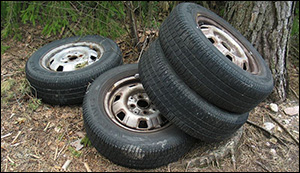Reducing tire waste by using completely degradable, synthetic rubber
23. 8. 2016 | American Chemical Society | www.acs.org
Scrap tires have been on environmentalists’ blacklist for decades. Scientists trying to rid us of this scourge have developed a new way to make synthetic rubber. And once this material is discarded, it can be easily degraded back to its chemical building blocks and reused in new tires and other products.
“The basic idea behind this project was to take a byproduct of the petrochemical industry and turn some of it into recyclable value-added chemicals for use in tires and other applications,” says Robert Tuba, Ph.D., one of the lead researchers on the project.

Currently, synthetic-rubber makers use butadiene as their base material, but its cost has recently gone up, opening the door to competition. So scientists turned to cyclopentene as a potential alternative. Calculations showed that polymerizing cyclopentene and degrading it under relatively mild reaction conditions — and thus requiring minimal energy and expense — should be possible.
Using ruthenium, a transition-metal catalyst, the researchers polymerized cyclopentene at 0 degrees Celsius and decomposed the resulting material at 40 to 50 degrees. For industry, these are low temperatures that do not require a lot of energy. Additionally, in the lab, they could recover 100 percent of their starting material from several polypentenamer-based tire additives they developed.
Read more at American Chemical Society
Image Credit: Wikipedia
-jk-




